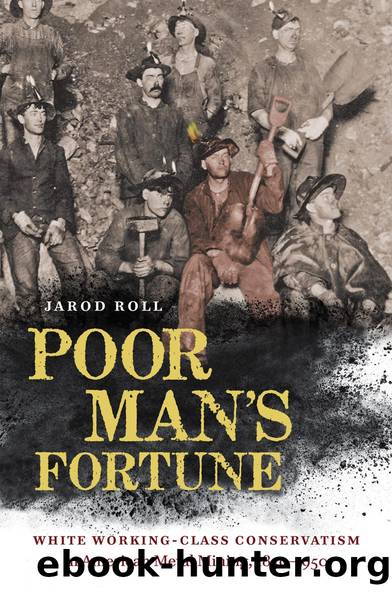Poor Man's Fortune by Jarod Roll

Author:Jarod Roll [Roll, Jarod]
Language: eng
Format: epub
Tags: History, United States, General, Political Science, Labor & Industrial Relations, Technology & Engineering, Mining
ISBN: 9781469656304
Google: dPXGDwAAQBAJ
Publisher: UNC Press Books
Published: 2020-04-08T00:58:58+00:00
Picher clinic grade card, 1929. Picher Mining Collection, folder 960, box 88, Pittsburg State University. Courtesy Baxter Springs Heritage Center.
Miners distrusted the new examination regime, especially the individual grades. âThe men thought that the work was mainly for the protection and benefit of the operators and of little, if any, benefit to them,â Meriwether reported in 1928. His weekly meetings with insurance adjustors, who took a keen interest in the exam results, belied the OPAâs public claims that the clinic was for the benefit of the miners. To allay suspicion, the OPA launched a publicity campaign to emphasize that the exams were entirely voluntary and would not result in anyone losing their job. In late 1927, the OPA posted large notices at all mines stating, âYou are not required to take this examination. It is available for you if you desire it. You are free to act as you wish in the matter.â The exam grades could still complicate employment for men who were new to the district or those looking to change employers. The clinicâs expansion coincided with reduced production in 1927 and early 1928. Mining companies reinstituted periodic shutdowns for days or weeks at a time that laid off hundreds of miners, 3,000 at the worst point in early 1928. Uncertain employment made it harder for miners to protest by switching jobs, as they had in the past, especially so for men with C or D cards. Miners learned to alter the first examination grade cards by switching out photographs with those on cards with higher grades or erasing and replacing the original information entirely. After several unsuccessful attempts to prevent fraud, the clinic began imprinting the cards with a Bureau of Mines seal that embossed the letter grade and the photograph. Meriwether was confident that the federal agencyâs imprimatur made the grades indelible.66
Meriwether gradually increased the clinicâs influence. In early 1929, he requested and received funds to treat sexually transmitted diseases, which exams had shown to be rampant. In its first six months, Meriwetherâs âVD sectionâ treated 363 cases of syphilis and 188 cases of gonorrhea. By his count, however, almost 300 additional syphilitics continued to work without treatment. Influenced by Parranâs interest in the social and economic effects of syphilis, Meriwether argued that these infections represented a serious compensation risk that rivaled the costs of tuberculosis. âThere is no excuse for the men with such diseases continuing to claim the right for employment,â he reported to the OPA. Meriwetherâs vigilance against sexual infections gave the clinic new invasive powers, literally. He instructed clinic physicians to perform prostatic massages to test the seminal fluid of any male patient who seemed likely to have gonorrhea. The OPA enthusiastically backed this broadened mission. Its welfare nurse reported uncooperative women with syphilis or gonorrhea to the local police, who forcibly treated them in the county jail.67
The OPA, Bureau of Mines, and Metropolitan Life renewed the clinic agreement for another two years in 1929. Meriwetherâs second annual report showed that the
Download
This site does not store any files on its server. We only index and link to content provided by other sites. Please contact the content providers to delete copyright contents if any and email us, we'll remove relevant links or contents immediately.
Whiskies Galore by Ian Buxton(41871)
Introduction to Aircraft Design (Cambridge Aerospace Series) by John P. Fielding(33064)
Small Unmanned Fixed-wing Aircraft Design by Andrew J. Keane Andras Sobester James P. Scanlan & András Sóbester & James P. Scanlan(32743)
Craft Beer for the Homebrewer by Michael Agnew(18140)
Turbulence by E. J. Noyes(7935)
The Complete Stick Figure Physics Tutorials by Allen Sarah(7307)
Kaplan MCAT General Chemistry Review by Kaplan(6866)
The Thirst by Nesbo Jo(6826)
Bad Blood by John Carreyrou(6543)
Modelling of Convective Heat and Mass Transfer in Rotating Flows by Igor V. Shevchuk(6391)
Learning SQL by Alan Beaulieu(6209)
Weapons of Math Destruction by Cathy O'Neil(6142)
Man-made Catastrophes and Risk Information Concealment by Dmitry Chernov & Didier Sornette(5921)
Digital Minimalism by Cal Newport;(5661)
Life 3.0: Being Human in the Age of Artificial Intelligence by Tegmark Max(5474)
iGen by Jean M. Twenge(5366)
Secrets of Antigravity Propulsion: Tesla, UFOs, and Classified Aerospace Technology by Ph.D. Paul A. Laviolette(5309)
Design of Trajectory Optimization Approach for Space Maneuver Vehicle Skip Entry Problems by Runqi Chai & Al Savvaris & Antonios Tsourdos & Senchun Chai(5011)
Pale Blue Dot by Carl Sagan(4908)
